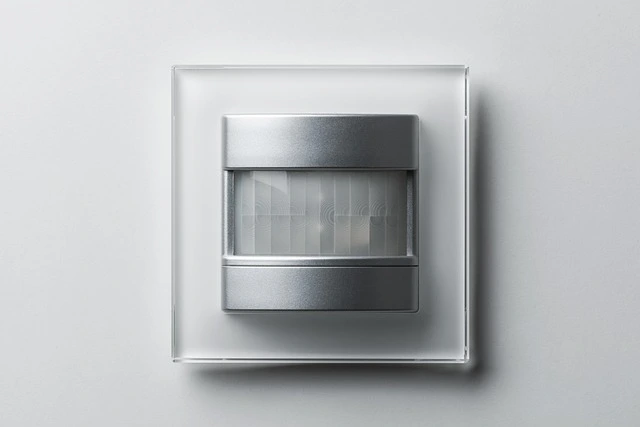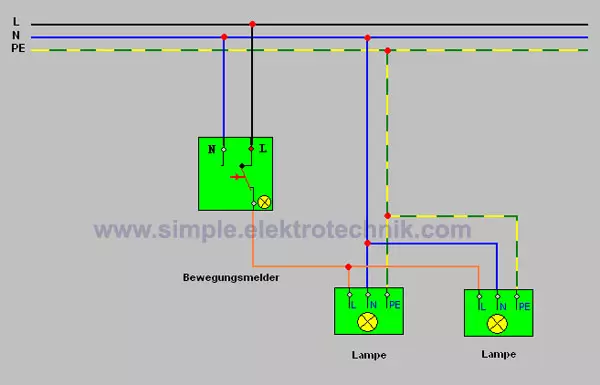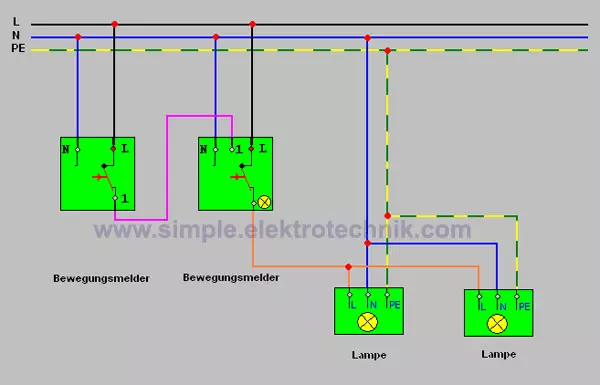Instructions for Installing and Connecting a Motion Detector:
A two-way switch is a simple type of electrical switch used to establish an electrical connection between two different states. It allows controlling an electrical load, such as a lamp or an outlet, from two different switch locations.
A typical example of using a two-way switch is controlling a lamp from one or two different locations, for instance, from the top and bottom of a staircase. When the switch is in one position, the lamp is turned on, and when it is switched to the other position, the lamp is turned off. The two-way switch enables controlling the lamp's state from both locations.
The Motion Detector

Structure and Function of a Motion Detector:
A motion detector consists of various components that, when combined, enable its function:
The main components of a motion detector are as follows:

- Motion Sensor
- Signal Processing Unit
- Switching Output
- Potentiometer for Activation Time
- Potentiometer for Ambient Brightness
- Potentiometer for Sensitivity
The motion sensor is the heart of the detector. There are various types of sensors, such as the passive infrared sensor (PIR) or the microwave sensor. The PIR sensor responds to infrared radiation emitted by moving objects, such as people. The microwave sensor continuously emits microwaves and detects changes in the reflected signal caused by movements.
The signals detected by the motion sensor are analyzed and interpreted by the signal processing unit. This unit checks whether the movements are relevant or just disturbances caused by animals or passing vehicles. The signal processing enables some intelligence in the motion detector to minimize false alarms.
When the signal processing unit detects relevant motion, it activates the switching output. This output provides an electrical signal used to control connected devices or appliances. Typically, it is used to turn on lighting, activate alarm systems, or start other electrical devices.
Operation:
When a person or object moves within the motion detector's detection range, the motion sensor registers the change in the surrounding field, whether through infrared radiation or reflected microwaves. The signal processing unit analyzes the detected signals to determine if the movement is relevant and not insignificant interference.
If the signal processing unit recognizes the movement as relevant, it activates the switching output, which turns on the connected electrical device or load. The duration for which the switching output remains active can vary depending on the settings, and after that, the load automatically switches off again.
The combination of these components allows the motion detector to respond to movements within its detection range, making it suitable for various applications such as lighting control, security systems, or energy-efficient automations.
Motion detectors are practical devices that often come with a built-in twilight switch to activate the lighting only in darkness. When a heat source moves within the detection range, the motion detector switches on the lighting for an adjustable period and automatically turns it off after that time has elapsed.
Most motion detectors offer their users two adjustment options:
Activation time:
This setting determines how long the consumer, for example, the lighting, should remain turned on.
Ambient brightness (light-dark threshold):
This setting defines the level of darkness at which the motion detector should be activated.
Another adjustable parameter is sensitivity, which determines how quickly the motion detector should react to detected movements.
In most motion detectors, the activation time starts counting once the last movement is detected. If the detector detects new movement during this time, the timer is reset. This ensures that the consumer is not switched off as long as a person stays within the motion detector's detection range for an extended period.
The diverse adjustment options make motion detectors highly adaptable and enable efficient use of lighting or other electrical consumers, leading to energy savings and increased security.
Proper Connection of a Motion Detector:
The correct connection of a motion detector also requires care and adherence to the manufacturer's instructions to ensure proper functionality. Here is an easy-to-understand guide for the correct connection of a motion detector:

- Remove the cover of the switch box where the motion detector will be installed.
- Take note of the positions of the connections on the motion detector. Typically, there are three connections: the input connection (L), the output connection (L↓), and the neutral wire connection (N).
- Connect the live wire (phase) of the circuit to the input connection (L) of the motion detector.
- Connect the output connection (L↓) of the motion detector to the consumer or the lamp that is to be controlled. This output switch turns the power supply to the lamp on or off.
- Connect the neutral wire connection (N) of the motion detector to the neutral wire of the circuit. In some cases, this may be optional, depending on whether the motion detector requires a separate power supply or not.
- If the motion detector has additional functions or settings, such as setting the switching time or the detection range, adjust them according to the manufacturer's instructions.
- Carefully check if all connections are firm and secure. Use appropriate connection terminals or screw connections.
The correct connection of the motion detector ensures smooth operation, as it turns the connected lamp or consumer on or off based on detected movement. If there are uncertainties or the need for assistance, it is advisable to consult a professional to avoid potential errors and ensure a safe installation.
Motion Detector Circuit Diagram - Simple Circuit

Motion Detector Circuit Diagram with 2 Motion Detectors

This circuit uses two motion detectors to switch on one, two, or any number of lamps. It is important to select appropriate motion detectors. When motion detector 1 detects movement, it sends a signal to motion detector 2, which then switches on the lamps.
Instructions for Installing and Connecting a Motion Detector:

- Make sure that the power supply for the circuit where the motion detector will be installed is turned off. Switch off the corresponding circuit breaker or remove the fuse.
- Remove the cover of the switch box to access the wiring.
- Take the motion detector out of its packaging and check if it is complete and undamaged.
- Identify the connections on the motion detector. Typically, there are three connections: the input connection (L), the output connection (L↓), and the neutral wire connection (N).
- Refer to the manufacturer's instructions to identify the correct connections. The input connection is usually labeled as "L," while the other connections may be labeled accordingly.
- Connect the input connection (L) of the motion detector to the live wire (phase) of the circuit. Ensure that the connection is secure and firm.
- Connect the output connection (L↓) of the motion detector to the phase of the load to be controlled, for example, a lamp or another electrical consumer.
- The neutral wire connection (N) of the motion detector is connected to the neutral wire of the circuit. In some cases, this may be optional, depending on whether the motion detector requires a separate power supply or not.
- Carefully check if all connections are firm and secure. Use appropriate connection terminals or screw connections.
- Reattach the cover of the switch box to its place.
- Turn the power supply back on by switching on the circuit breaker or inserting the fuse.
- Test the motion detector to ensure that it functions correctly. Move within its detection range to see if it switches the connected load on and off accordingly.
Ensure that the motion detector is properly mounted and aligned to ensure effective detection of movements. The exact procedure may vary depending on the manufacturer and model, so it is important to follow the specific instructions provided by the motion detector's manufacturer.

Motion detectors have various applications in electrical engineering.
Here are some examples:
Motion detectors have versatile applications in electrical engineering, offering a convenient and efficient way to control electrical circuits. Here are some examples:
- Lighting Control: Motion detectors are frequently used in lighting circuits. They automatically switch on the light when people or objects move within their detection range. Once no movement is detected, the motion detector switches off the light, saving energy by activating the lighting only when needed.
- Security Lighting: Motion detectors play a crucial role in security systems. They are used, for instance, to equip areas such as entrances, garages, or outdoor spaces with security lighting. When someone approaches the monitored area, the motion detector turns on the light, which can deter potential intruders.
- Energy-Efficient Lighting Control: Motion detectors are also used in energy-efficient lighting systems. In offices, hallways, or public buildings, they turn on the light only when people are nearby. Once the area is left, the motion detector automatically switches off the light to avoid energy waste.
- Automatic Door Opening: Motion detectors find application in automatic door opening systems, such as in supermarkets or public buildings. When a person approaches the door, the motion detector senses the approach and triggers the door's opening.
- Surveillance Systems: Motion detectors are also used in surveillance systems. They can be used in conjunction with cameras or alarm systems to detect unusual movements in specific areas and trigger appropriate actions.
The diverse applications of motion detectors make them an extremely useful and practical component in electrical engineering. They not only contribute to safety but also enable efficient energy use in various aspects of daily life and industry.
Elektrosicherheit: Richtlinien und Vorsichtsmaßnahmen für einfache elektrotechnische Arbeiten
Die Sicherheit hat oberste Priorität.

- Alle hier bereitgestellten Anleitungen und Informationen dienen rein informativen Zwecken und sollen ausschließlich zur Informationsbeschaffung und Weiterbildung verwendet werden. Sie sollten nicht als Ersatz für professionelle Beratung angesehen werden. Bei Zweifeln empfiehlt es sich, einen qualifizierten Elektriker hinzuzuziehen, um fachkundige Unterstützung zu erhalten.
- Es ist wichtig, die örtlichen Vorschriften und Bestimmungen bei elektrischen Arbeiten zu beachten. Arbeiten mit Strom sollten nur von qualifizierten Fachleuten durchgeführt werden, da sie lebensgefährlich sein können.
- Fehler in Anleitungen und Schaltbildern sind möglich. Der Anbieter übernimmt keine Gewähr oder Haftung für Schäden oder Verletzungen, die aus der Umsetzung der bereitgestellten Informationen resultieren könnten. Es liegt in Ihrer Verantwortung, die Richtigkeit der Informationen zu überprüfen und die erforderlichen Sicherheitsvorkehrungen zu treffen.
- Die Verwendung geeigneter persönlicher Schutzausrüstung (PSA) ist entscheidend, um die Sicherheit bei elektrotechnischen Arbeiten zu gewährleisten. PSA schützt vor Stromschlägen, Augenverletzungen, thermischen und mechanischen Gefahren. Es ist jedoch wichtig zu beachten, dass PSA allein nicht ausreicht und durch Fachwissen, Fähigkeiten und die Einhaltung von Sicherheitsvorschriften ergänzt werden muss.
- Arbeiten an Teilen, die unter Spannung stehen, sind strengstens untersagt. Vor Beginn der Arbeiten müssen geeignete Sicherheitsvorkehrungen getroffen werden, einschließlich des Freischaltens der Anlage.
- Bei Schäden durch mangelhafte Elektroinstallation haftet der Errichter der Anlage gemäß den geltenden gesetzlichen Bestimmungen.
- Diese Zusammenfassung von Richtlinien und Vorsichtsmaßnahmen ist nicht umfassend. Bei Unsicherheiten ist es ratsam, einen qualifizierten Elektriker zu konsultieren oder sich an örtliche Vorschriften und Bestimmungen zu halten, um maximale Sicherheit zu gewährleisten.
- Die ordnungsgemäße Installation und Wartung von elektrischen Anlagen und Geräten ist von großer Bedeutung, um mögliche Gefahren zu minimieren und ein sicheres Umfeld zu schaffen.